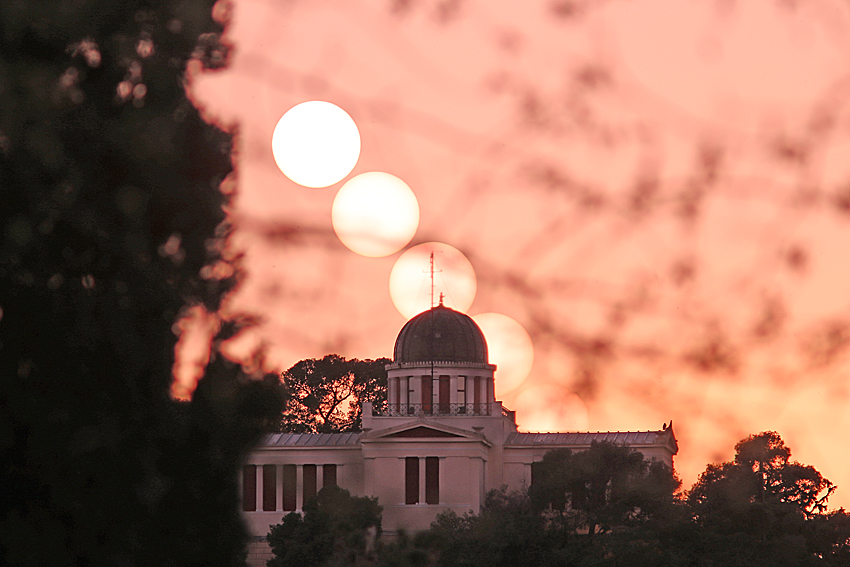
Our sun and closest star is believed to be approximately 4600 million years old and is composed (by mass) of hydrogen (74.5%), helium (23.5%)
and various other heavier elements (2%) such as oxygen and carbon. Due to this gaseous state, the sun does not rotate about its axis at one
uniform rate but has the poles rotating at a slower rate than the equatorial region. It has a central temperature of 14 million degrees
whereas the surface temperature is a mere 5500 °C. With a diameter of 1.4 million km, it is about 109 times as wide as Earth whereas with a
mass of 2 x 1030 kg, it is 335,000 times more massive than Earth. Of interest is the observation that its density of 1400
kg/m3 is only slightly more dense than water (1000 kg/m3).
Although the rising sun may seem to occur at approximately the same azimuth when observed from day to day, a longer term observational
project
will reveal this to be far from the truth. In fact, if we were to mentally note the azimuth of the rising sun around summer solstice in June
and repeat this exercise around winter solstice in December, we will note that the sun has shifted by approximately 65° during the intervening
six months!
This "moving target" involving the rising (or setting) sun is due to the elliptical nature of our planet's orbit around the sun which is
responsible for the variable arrival of the sun on the local meridian by up to 16 minutes early or late and the "Equation of Time" which is
described and documented elsewhere on this site along with the variable altitude due to
earth's tilt in its axis of rotation (23.45°) relative to its orbital plane.
Note: The image below is an extension of a prolonged effort to capture the Sun and Moon and Sun against notable
foregrounds. The primary task in such an exercise is to very precisely reverse engineer the perspective of the foreground of interest with
respect to its physical azimuth and altitude from my shooting location approximately 550 meters east of the stunning and picturesque National
Observatory of Athens situated in central Athens and, more specifically, the Hill of the Nymphs. Such a distance was both desireable and ideal
so as to have a balance between the apparent size of the observatory in the foreground and the time series involving Sol in the background and
as indicated by the image below.
The National Observatory of Athens at the Hill of the Nymphs was constructed in the 1840's following a generous donation by the greek ambassador
to Vienna, Baron Georgios Sinas, and is neoclassic in its design. Perhaps it is best known for being directed by Johann Friedrich Julius Schmidt
between 1858-1884 and who produced an amazing volume of scientific work comprised of variable star, planetary, solar and lunar observations as
well as the epic two-meter wide "Topographical Chart of the Moon" involving the visible side of the lunar surface and where he drew 30,000 craters
and craterlets which he personally observed.
Note: For additional photos of the sun and/or full moon against other well-known Greek archaeological grounds
and sites, please click here.
|
Body: Sun Mass: 332,900 x Earth Mean Eq Diameter: 109.1 x Earth Distance: 149 million km RA / Dec: 23h 41m 41s / -01° 58' 59" Diameter: 32.16' Magnitude: -26.8 |
 |
Date: Mar 15, 2018 17:59:07 UT+2 - 18:08:09 UT+2 Location: Ancient Agora, Athens, Greece Equipment: Canon EOS 6D Mk I Baader BCF2 Filter Baader ND5 Filter SMC Pentax 67 200/f4 SMC Pentax 67 Rear Conv 2x Exposures: 5 x 1/30 sec ISO 100 JPG image format 5472x3648 Image Size Custom White Balance Manual Mode Continuous Servo Mode Software: Digital Photo Pro V4.6.30.0 Photoshop CS5 Processing: Layers and Lighten Resampling JPG Compression |